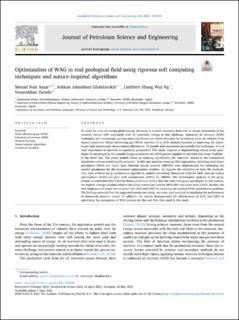| dc.contributor.author | Nait Amar, Menad | |
| dc.contributor.author | Jahanbani Ghahfarokhi, Ashkan | |
| dc.contributor.author | Ng, Cuthbert Shang Wui | |
| dc.contributor.author | Zeraibi, Noureddine | |
| dc.date.accessioned | 2022-03-10T12:05:31Z | |
| dc.date.available | 2022-03-10T12:05:31Z | |
| dc.date.created | 2021-09-07T12:01:35Z | |
| dc.date.issued | 2021 | |
| dc.identifier.citation | Journal of Petroleum Science and Engineering. 2021, 206 . | en_US |
| dc.identifier.issn | 0920-4105 | |
| dc.identifier.uri | https://hdl.handle.net/11250/2984253 | |
| dc.description.abstract | To meet the ever-increasing global energy demands, it is more necessary than ever to ensure increments in the recovery factors (RF) associated with oil reservoirs. Owing to this challenge, enhanced oil recovery (EOR) techniques are increasingly gaining more significance as robust strategies for producing more oil volumes from mature reservoirs. Water alternating gas (WAG) injection is an EOR method intended at improving the microscopic and macroscopic displacement efficiencies. To handle and implement successfully this technique, it is of vital importance to optimize its operating parameters. This study targeted at implementing robust proxy paradigms for investigating the suitable design parameters of a WAG project applied to real field data from “Gullfaks” in the North Sea. The proxy models aimed at reducing significantly the rum-time related to the commercial simulators without scarifying the accuracy. To this end, machine learning (ML) approaches, including multi-layer perceptron (MLP) and radial basis function neural network (RBFNN) were implemented for estimating the needed parameters for the formulated optimization problem. To improve the reliability of these ML methods, they were evolved using optimization algorithms, namely Levenberg–Marquardt (LM) for MLP, and ant colony optimization (ACO) and grey wolf optimization (GWO) for RBFNN. The performance analysis of the proxy models revealed that MLP-LMA has better prediction ability than the other two proxy paradigms. In this context, the highest average absolute relative deviation noticed per runs by MLP-LMA was lower than 3.60%. Besides, the best-implemented proxy was coupled with ACO and GWO for resolving the studied WAG optimization problem. The findings revealed that the suggested proxies are cheap, accurate, and practical in emulating the performance of numerical reservoir model. In addition, the results demonstrated the effectiveness of ACO and GWO in optimizing the parameters of WAG process for the real field data used in this study. | en_US |
| dc.language.iso | eng | en_US |
| dc.publisher | Elsevier | en_US |
| dc.rights | Navngivelse 4.0 Internasjonal | * |
| dc.rights.uri | http://creativecommons.org/licenses/by/4.0/deed.no | * |
| dc.title | Optimization of WAG in real geological field using rigorous soft computing techniques and nature-inspired algorithms | en_US |
| dc.type | Peer reviewed | en_US |
| dc.type | Journal article | en_US |
| dc.description.version | publishedVersion | en_US |
| dc.source.pagenumber | 12 | en_US |
| dc.source.volume | 206 | en_US |
| dc.source.journal | Journal of Petroleum Science and Engineering | en_US |
| dc.identifier.doi | 10.1016/j.petrol.2021.109038 | |
| dc.identifier.cristin | 1932002 | |
| cristin.ispublished | true | |
| cristin.fulltext | original | |
| cristin.qualitycode | 2 | |

